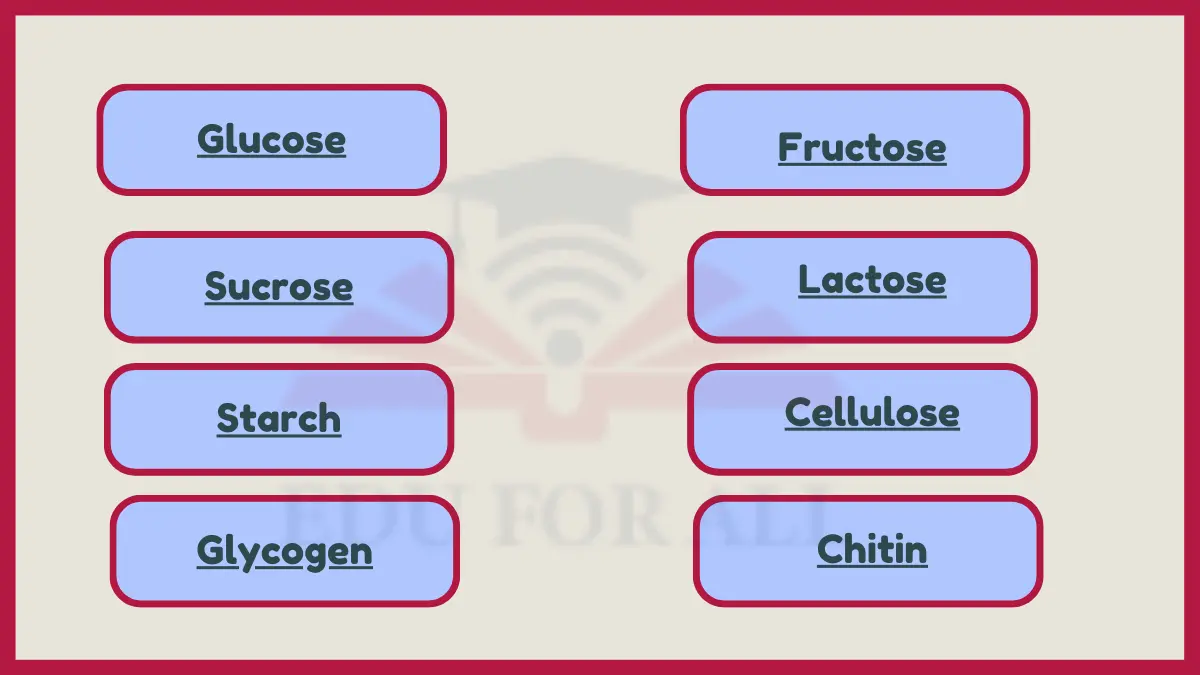Carbohydrates are organic compounds made up of carbon, hydrogen, and oxygen atoms that provide energy and structure to organisms. Some important carbohydrates include monosaccharides like glucose and fructose, disaccharides like sucrose and lactose, polysaccharides like starch and cellulose, and glycoconjugates like glycoproteins and proteoglycans.

Examples of Carbohydrates
Here are a few Examples of Carbohydrates:
1. Glucose
Glucose is a simple monosaccharide sugar that is a major energy source for cells. It is transported via bloodstream and taken up by cells with the help of insulin. As a building block for larger carbohydrates, glucose is essential to metabolism and bioenergetics.
2. Fructose
Fructose is a monosaccharide sugar found in many fruits, vegetables, and honey. It is sweeter than glucose and has different metabolic effects. Fructose can only be metabolized by the liver, unlike glucose which can be used by all cells. Too much fructose consumption has been linked to non-alcoholic fatty liver disease.
3. Sucrose
Sucrose, or table sugar, is a disaccharide composed of one glucose and one fructose molecule bonded together. Sucrose is found naturally in many plants and is extracted from sugarcane or sugar beets for human consumption. It provides sweetness to foods and beverages.
4. Lactose
Lactose is the primary sugar found in milk. This disaccharide is made up of one glucose and one galactose molecule. Lactose intolerance is common in adults since they lack the lactase enzyme to properly digest it. Infants produce lactase for digestion of lactose in breast milk or formula.
5. Starch
Starch is a polysaccharide of many glucose units bonded together. It serves as an energy storage molecule in plants and is a major source of carbohydrates in the human diet. Sources of starch include potatoes, rice, wheat, and corn.
6. Cellulose
Cellulose is a structural polysaccharide that gives strength and stability to plant cell walls. It is made up of long chains of glucose, linked by beta-glycosidic bonds. Humans cannot digest cellulose, but it provides important dietary fiber.
7. Glycogen
Glycogen is the storage form of glucose in humans and animals. This branched polysaccharide is synthesized in the liver and muscles for ready glucose supply. Glycogen breakdown releases glucose between meals or during exercise when glucose levels fall.
8. Chitin
Chitin is the second most abundant natural polysaccharide after cellulose. This amino sugar is found in fungal cell walls and the exoskeletons of arthropods like insects and crustaceans. It provides structural stability.
9. Peptidoglycan
Peptidoglycan forms a mesh-like layer outside the plasma membrane of bacteria. It contains sugars and amino acids, giving structural integrity to bacterial cell walls. The peptidoglycan layer is a target for some antibiotics like penicillin.
10. Glycosaminoglycans
Glycosaminoglycans like hyaluronic acid are important glycoconjugates in connective tissues. These carbohydrate compounds help retain water to lubricate joints, hydrate skin, and provide compression resistance.

